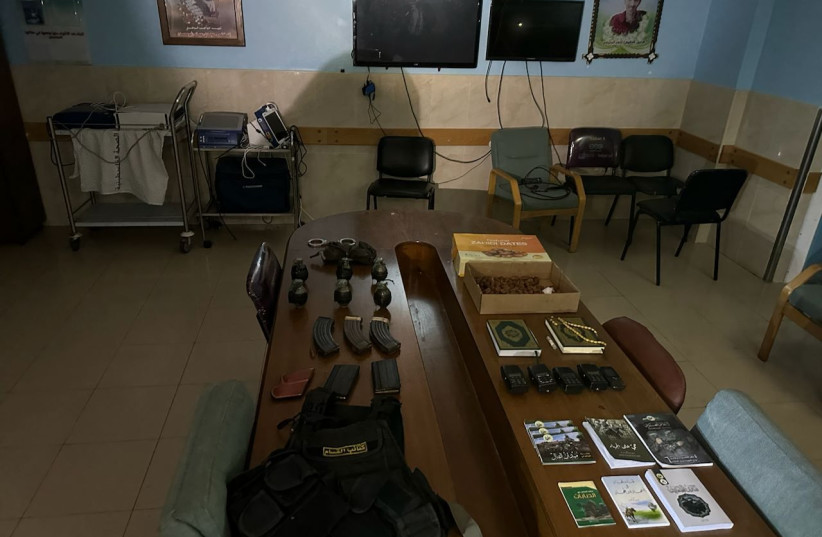Did 200 Hamas forces, who IDF intelligence claims were present at Shifa Hospital after Hamas’s October 7 attack on Israel, vanish out of thin air?
All of the following could change radically if the IDF finds a larger smoking gun overnight Wednesday or on Thursday, but at press time, the IDF had presented a much weaker case to the world about Hamas’s presence at the hospital than expected.
The IDF announced zero arrests and even foreign media only mentioned two arrests, with five Hamas terrorists being killed just outside the hospital, but none inside – not even a single gunfight.
How did we get here?
This raises a number of issues, but before getting into those, how did we get here?
Since 2014, top defense officials had repeated that top Hamas officials spent the 2014 Gaza conflict and other conflicts hiding in tunnels under Shifa Hospital.

Knowing this, there were high expectations from defense analysts once the Gaza invasion started in late October, that the IDF would make a priority of taking over Shifa Hospital to unmask it and Hamas’s vast tunnel network and military apparatus there as soon as possible.
For much of the last week, the IDF and Israel have suffered horrible press coverage globally and immense criticism from both standard critics and some allies for its siege of Shifa.
What was unclear was when the IDF would finally go in, and what was holding it back.
Was it waiting to take over Shifa more because of global pressure or because of complex operational realities, such as the need to make extra detailed plans in case there were hostages on site and to avoid killing doctors and patients?
The answer to that question may only come at a later date, and prior to the IDF going in, several senior defense officials gave contradictory answers on the issue, showing how profoundly complex it was.
The IDF presented Hamas having thrown its uniforms on the ground, military equipment hidden behind an MRI machine, intelligence items, and surveillance cameras being covered to shield recording Hamas’s movements – but this is pretty meager evidence after the size of the IDF claims.
Did all of the Hamas forces flee? Or did they blend in with the civilian patients?
Why did the IDF find more traces of hostages and more powerful weapons, like rocket propelled grenades, at the Rantisi Hospital only a few days ago?
Did Hamas learn from the evidence it left behind for Israel there and do a better clean up job before fleeing Shifa?
If so, why did the IDF do Rantisi first? Did it not realize that Hamas might learn from that experience and clean up better at Shifa?
This raises some grand strategy issues and trends for the war.
Yes, the IDF has control of northern Gaza and all of the key buildings and symbols of Hamas’s rule, yes it has destroyed significant weapons, significant numbers of tunnels, and killed probably more than 5,000 Hamas terrorists between Gaza and the southern Israel battles.
But if Hamas has 30,000 fighters as the IDF recently said, the vast majority of Hamas’s forces have not been touched.
A week or so ago, the IDF could more credibly argue it would find most of them in tunnels in northern Gaza.
But at this point, after Hamas escaped Rantisi and Shifa, are they all in southern Gaza? Blended into the civilian population in both the North and the South? It is possible some have even escaped Gaza to other territories?
Did the IDF just miss the ball on this or was it hoping to scare most of Hams out of the North without too much fighting, or to focus more on breaking the symbols of its rule?
On the positive side, Shifa could have been a disastrous blood bath. Hundreds of civilians could have been killed and on camera in real time? The IDF can say it succeeded in intimidating Hamas into leaving to avoid the trap.
But if the vast majority of Hamas is still out there and hard to discern among the civilian population, maybe Hamas just decided to switch from war to insurgency hit and run tactics even before the great war happened?
Maybe it is just waiting until Israel lets its guard down, starts withdrawing its heavy weapons, and starts planting soldiers in stationary positions, before it starts to strike back.
The taking of Shifa was supposed to be the largest moment of the war, when Hamas was the most broken and possibly Hamas’s top leaders would be caught or killed.
Instead, taking control has raised more questions about whether Israel can achieve its primary objective of keeping Hamas down long-term, and that is without even getting near the question of rescuing hostages, which IDF commanders are still avoiding discussing more than five weeks after the hostages disappeared.
Then again, maybe the IDF will find its smoking gun on Thursday…
